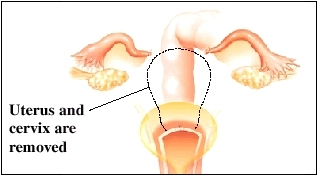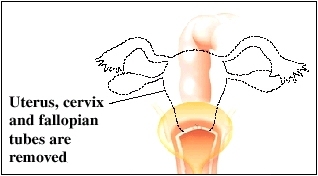Hysterectomy: Surgical Procedures
A hysterectomy is an operation to remove a woman's uterus. It can relieve such symptoms as severe pain and bleeding. If you have cancer, it may save your life.
The Surgical Procedures
|
 During a total (or simple) hysterectomy, the uterus and cervix are removed. In a subtotal hysterectomy, the uterus is removed.
|
|
 During a hysterectomy with salpingo-oophorectomy, the uterus, cervix, ovaries and fallopian tubes are removed.
|
Before the surgery, you and your doctor will discuss how the uterus will be reached. Often, the approach your doctor recommends will depend on the reason for your surgery. You'll also talk about the type of hysterectomy you will have. The uterus, as well as the ovaries and fallopian tubes, can be removed with any of the approaches.
Reaching the Uterus
Vaginal Hysterectomy: An incision is made inside the vagina. The uterus is then removed through the vagina. This can be done if the uterus is not too large, or if it has dropped down into the vaginal canal.
Laparoscopic Hysterectomy: Small instruments are inserted through tiny incisions in the abdomen. The instruments are used to view and move the organs.
-
During LAVH (laparoscopically assisted vaginal hysterectomy), the uterus is removed through the vagina.
-
During LSH (laparoscopic supracervical hysterectomy), the cervix is left in place and the rest of the uterus is removed through the abdominal incisions.
-
With the use of robotic technology, more complex surgeries can be done through very small incisions. The incision site may depend on the location of your problem.
Abdominal Hysterectomy: A 4- to 6-inch incision is made in the abdomen. The incision can be horizontal (side-to-side) or vertical (up-and-down). The uterus is removed through the incision.
Types of Hysterectomy
Removing the Uterus: During a total (simple) hysterectomy, the uterus and cervix are removed. In a subtotal hysterectomy (supracervical), the uterus is removed, but the cervix is not. In either case, the ovaries and fallopian tubes remain. If you have not yet reached menopause, the ovaries will keep producing hormones. You may still feel the changes of menstrual cycles. These can include bloating, breast changes, and mood swings. But, since you no longer have a uterus, you will not have periods. Eggs released by the ovaries are absorbed by your body. This means you cannot become pregnant.
Removing the Uterus, Ovaries, and Tubes: During a hysterectomy with salpingo-oophorectomy, the ovaries and fallopian tubes are removed as well as the uterus. The tubes and ovaries often are removed on both sides (bilateral). When both ovaries are removed, the body's estrogen level drops quickly. This can trigger symptoms of menopause (surgical menopause). Symptoms are most noticeable in women who did not reach menopause before surgery. These symptoms can be treated.
Planning Your Treatment
After going over the results of your exam and any tests, you and your doctor will make a treatment plan. Options may include hysterectomy by itself or along with other treatments. As you create the plan, your doctor may discuss the following questions with you:
-
How severe is your problem? Is your health problem getting in the way of your daily life? Is the problem getting worse? If your answers are "no," treatment other than hysterectomy may be suggested.
-
Do you want to have children? If you do, your doctor may discuss other types of treatment.
-
Should the ovaries be removed too? This may be discussed if you have cancer or are at an increased risk for cancer. In such cases, your doctor may suggest removing the ovaries and fallopian tubes along with the uterus. If the ovaries are to be removed, talk to your doctor before the surgery about hormone therapy (HT).
Risks and Possible Complications of a Hysterectomy Include
-
Side effects from the anesthesia
-
Infection
-
Bleeding, with a possible need for transfusion
-
Damage to nearby organs
-
Blood clots in the legs or lungs

